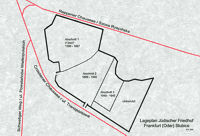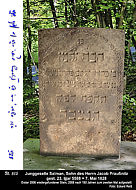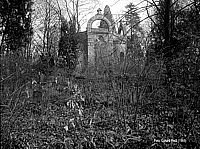H The Jewish Cemetery
 A Jewish community needs not only a synagogue but also a Jewish cemetery. Believers can find their final rest here according to the laws of Judaism. The former Jewish cemetery for the city of Frankfurt (Oder) is now found in S?ubice, where the road forks for Reppen/Rzepin and Crossen/ Krosno Odrza?skie. It was first mentioned in documents from 1399.
A Jewish community needs not only a synagogue but also a Jewish cemetery. Believers can find their final rest here according to the laws of Judaism. The former Jewish cemetery for the city of Frankfurt (Oder) is now found in S?ubice, where the road forks for Reppen/Rzepin and Crossen/ Krosno Odrza?skie. It was first mentioned in documents from 1399.
Even before the city Frankfurt an der Oder is founded, Jews who have been expelled from Western Europe settle in this area. It is also known that they bury their dead on the land of the trading family Hokemann, east of the Oder. In 1399 the site becomes property of Frankfurt city, which renews the Jewish right to bury here. That makes the Jewish cemetery in today's S?ubice is one of the oldest Jewish burial places in Central Europe.
If you follow the street to Krosno Odrza?skie, you see the fenced-in cemetery on the left. Three stones can be seen behind the fence. These are rebuilt headstones in memory of three rabbis buried here: Sacharja Mendel von Podheiz, Joseph Meir Theomim and Jehuda Leib Margaliot.
Joseph Meir Theomim is probably the best known of them. He lived from 1727 to 1792. His works, including "Pri Megadim", reformed the Jewish dietary laws and remain an essential part of rabbi training to this day. On the anniversary of his death - early May according to the Christian calendar - many of the faithful make a pilgrimage to the cemetery in his memory.
The stone furthest to the left commemorates the Frankfurt rabbi Sacharja Mendel von Podheiz, that on the right the rabbi Jehuda Leib Margaliot. The latter authored widely propagated books on subjects like Biology, Grammar and, above all, Torah studies.


In Jewish cemetery culture, a cemetery is sacrosanct and may neither be changed nor terminated. Therefore, the cemetery you see here was extended twice. The first and oldest section encompasses the area to the left of the three headstones and is used until the mid 19th century. It lies on a hill of 35 to 40 metres, the so-called Jews' Hill, whose name is derived form the cemetery. The second section, in the middle, is in operation from then until 1940. After that, the new, third section is used, the area to the right of and above the headstones. But only a few funerals take place here. Because of the terrible times, some of these even happen without headstones. The last official Jewish funeral takes place here in 1944.
The first section was surrounded by a low stonewall of about 60 cm and is relatively small, especially considering the long time it was used. This is linked to the historical expulsions of Jews from the city, which meant the cemetery remained unused again and again. The wall around the second section was made of yellow brick and was considerably higher than that of the first section, namely 2 metres to 2.5 metres. This is a noticeable difference to the old wall and indicates a liberalisation of the synagogue community. According to Jewish law the cemetery should actually be visible from the outside.
 The design of graves also allows us to see an increasing similarity to Christian cemetery culture. The Association of Jewish Front-line Soldiers ("Reichsbund jüdischer Frontsoldaten") donated a monument in the cemetery to Jewish soldiers who fell in the First World War. This bears witness to the assimilation of Jews into German society, even if the inauguration celebration in 1937 takes place under the eyes of the Gestapo. The design of graves also allows us to see an increasing similarity to Christian cemetery culture. The Association of Jewish Front-line Soldiers ("Reichsbund jüdischer Frontsoldaten") donated a monument in the cemetery to Jewish soldiers who fell in the First World War. This bears witness to the assimilation of Jews into German society, even if the inauguration celebration in 1937 takes place under the eyes of the Gestapo.
In the pogrom night in November 1938, prayer books, flags and Torah scrolls can be rescued form the damaged Frankfurt synagogue. The Christian cemetery gardener, Otto Billerbeck, buries them according to Jewish custom in the cemetery. Otto Billerbeck has held his position at the Jewish cemetery since 1919, following on from his father and grandfather. After state pressure forces his dismissal in 1941, he continues to look after the burial place in spite of being forbidden to. He lives in a house directly beside the cemetery, on the road to Krosno Odrza?skie. Today one can even see the foundations of the house to the right of the three headstones. It was fenced in, together with the cemetery. The trees mark the former drive up to the house.
In 1941 over 100 Jewish victims from the Finkenheerd work camp are laid to rest in a mass grave here. After the end of the war, from May to September 1945, German soldiers and home guard people are buried here. None of hem gets a headstone or memorial stone.
After the Second World War, the area east of the Oder - including the Jewish cemetery - becomes part of the Polish state. The Frankfurt Dammvorstadt becomes S?ubice. The cemetery, which has not been destroyed, lies derelict until the mid 1970s and is then completely destroyed, like many other burial places from the German time. In 1975 the building of a restaurant is begun on the cemetery grounds. It is commonly known by Poles as "Restauracja pod trupkiem", or "the corpse restaurant." After the political changes, the new owner opens a nightclub here. Jewish clerics are shocked. The remains of the foundations are still clearly visible today, above the three memorial stones.
Eckard Reiß, member of the Historical Society of Frankfurt (Oder) e.V. reports further:
With the political changes in Poland, the whole site was sold and privatised and after the political scandal in the USA, the nightclub was closed and the city authorities in.
Today the site is maintained by the Warsaw Jewish community and the foundation for the protection of Jewish heritage (Fundacja Ochrony Dziedzictwa ?ydowskiego). The work done on the cemetery up to now thanks its financing above all to the Kastenbaum foundation. Eckard Reiß adds:
That is an American endowment that collects money from Jews worldwide for, among others, this cemetery, to be able to pay for the work still to be done. And at the headstones of the three rabbis, on the concrete wall, a tablet of thanks refers to that.
The new stones were officially inaugurated in May 2004. After the irreversible destruction of the cultural-historical gem that this age-old cemetery is, and following continuing desecrations, it has been decided to close the cemetery to the public. A solid fence has been built around the cemetery to let the dead find rest.
From the opposite side of the street, one can make out a white wall behind the headstones. The earth that was shifted and taken away in the building works of the 1970s has been brought there, and a common burial place established. Along the street to Rzepin, some of the headstones re-erected in recent years in the oldest burial section can be seen from outside the cemetery.
Christine Körner, student at the European University Viadrina
|